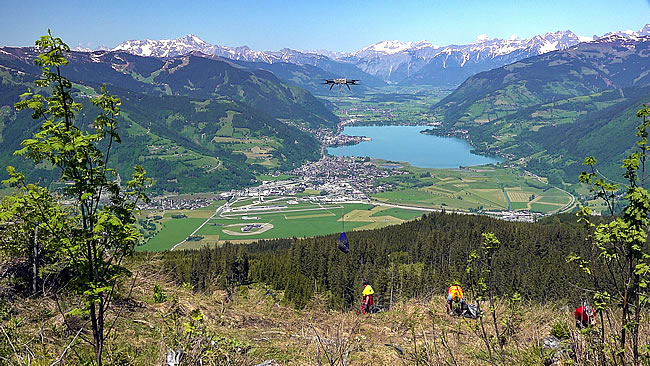Drones Help to Reforest the Austrian Mountains
![]()
Guest post by Steve Rout
The Austrian Federal Forestry Service is testing the use of drones to help reforest steep mountains in remote areas.
The Forestry Service manages around 15% of the country’s woodlands. Some of the timber stands at higher elevations are known as “Schutzwälder” (‘protection forests’) as they perform an important safety function in helping to reduce the risk of avalanches and landslides.
The test flights were carried out in the Pinzgau region of Salzburg near the resort town of Zell am See. Seedling were flown up to forestry workers using a heavy-duty transport drone.
Generally, reforestation involves the seedlings being carried up into inhospitable and dangerous terrain on the backs of forestry workers or the use of expensive transport helicopter services.
“An electronically operated transport drone is low-noise and emission-free. This technology has the potential to become an environmentally- and climate-friendly means of transport in steep terrain,” says Rudolf Freidhager, the Federal Forestry Board member responsible for forests, about the successful maiden flight. “This would literally relieve our forestry workers of a great deal of the burden and further reduce the potential risk of accidents during forestry work”.

Using drones to restore healthy forests
For its first forest flight, the 2×2-meter transport drone was loaded with about 200 young larch and spruce plants with a total weight of 15 kilograms.
The drone climbed 300m in altitude in a few minutes over steep terrain and successfully deposited the young trees at an altitude of around 1700m above sea level. The flight route was determined using precise GPS data.
When fully loaded, the load drone can carry up to 80 kilograms. This would correspond to about 1,000 young tree seedlings.
“In a mountainous country such as Austria, protection forests play an important role as natural protection against hazards such as avalanches and rockfall. Their ongoing and careful care is vital for survival, especially in times of climate change,” says Freidhager.
The innovative use of drones could make the often-challenging reforestation work in difficult terrain much easier in the future. In 2018 alone, the Federal Forestry Service planted around two million young larches, white firs, spruces and mountain maples.

Sustainable forestry 4.0
Digital processes and state-of-the-art technology are already an integral part of sustainable forestry today. “As the country’s largest forest manager, we play a pioneering role,” says Freidhager.
The entire timber harvesting and logistics process is already controlled digitally via electronic delivery dockets. Digital forest maps for mobile phones and tablets or digital forest management plans are also part of everyday forest life.
The entire district staff is equipped with tablets on which forest maps and all forest data can be called up at any time at the touch of a button.
The possible future areas of application for drones are many and varied:
- Delivery of plants and material for reforestation
- Digital registration of forestry land borders
- Support in the management of bark beetle infestation
- Estimating timber damage after extreme weather events
The test drone project was organised by IONICA, a series of events for innovative solutions for tomorrow’s mobility, and monitored by Naturfreunde Österreich (‘Friends of Nature Austria’) to explore possibilities for the environmentally friendly supply of hard-to-reach huts in the Alpine region.
Author Bio: Steve is a former professional journalist who now writes about sights, events and outdoor activities in his adopted home of Austria. You can read more of his work on his site AustriaDirect.

